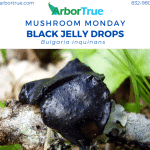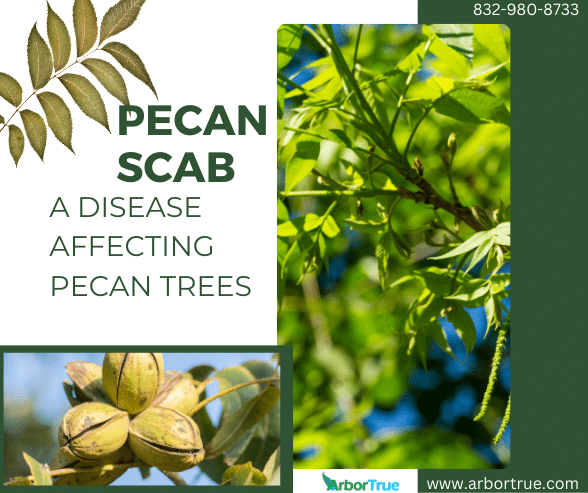
They’ve Got a Lot of Gall: Cynipid Wasps
September 18, 2024
Mushroom Monday: Black Jelly Drops (Bulgaria inquinans)
September 23, 2024
Pecan Scab: A Disease Affecting Pecan Trees
Pecan scab is a disease that can affect pecan trees (Carya illinoinensis). It can cause lesions on stems and leaflets and cause damage to nuts. Learn more about this disease in today’s TrueTreeTalk blog post.
What is Pecan Scab?
Pecan scab is a disease caused by a pathogen called Fusicladium effusum. This pathogen has been known by various names including Cladosporium caryigenum and Fusicladium caryigenum. The disease affects pecan trees (Carya illinoinensis), as well as other trees in the genus, and it is common in the U.S. southeast.
What are the Symptoms of Pecan Scab?
The disease symptoms appear in a similar way on the different parts of the plant. It can infect twigs, leaflets, and shell coverings (shucks). It causes small black/brownish green circular lesions to form. These lesions are small, ranging in size from around one to five millimeters, and they can merge together as they grow. It can also affect the catkins of the tree as well as buds that are dormant.
When the lesions first appear, they can look velvety. This is because they produce spores called conidia. Over time, the lesions become harder and change in color, becoming a silver/brown color to a dark shade of gray. Later, they can dry out and crack and fall from leaflets.
When lesions appear on emerging shoots, they look sunken because tissue around them swells. These lesions can last for multiple seasons.
How Does Pecan Scab Impact Trees?
Pecan scab can have a number of impacts on trees. If the infection is severe, it can cause defoliation, and can cause the nuts to be smaller and of lower quality. It can also cause the tree to release the nuts before they are fully developed and can cause trees to have less growth in their stems. Additionally, it can cause the shuck to stick to the nut’s shell, making shelling difficult. It can also cause nut surfaces to crack, which can lead to other infections, including pink mold fungus (Cephalothecium roseum).
Additionally, lesions can reduce the plant’s leaflet’s ability to photosynthesize. This can cause the tree to bear nuts in alternate years.
What is the Life Cycle of Fusicladium caryigenum?
Fusicladium caryigenum reproduces asexually through spores called conidia. When the spores germinate, they form tubes that go into the tissue of the host. From the tube, hyphae grow into the host. As growth continues, the cuticle of the tissue ruptures and the lesions form. The fungus overwinters and then the spores are released in the spring and are blown by the wind.
What Conditions Allow For Infection?
The spores require moisture, as well as the right temperature (between 68 and 86 degrees Fahrenheit) on the plant for infection to occur. Generally, the infection attacks young parts of the plant. When infections happen early, they can be severer and there can be more loss of nuts. Lesions can appear after seven to nine days following infection. The longer the leaflets are wet, the more lesions that will appear.
Trees need to be wet for many hours for infection to happen. How often it rains and how long the tissue of the tree stays wet, have a greater impact on how the tree will get infected than the amount of rain. When trees stay wet overnight, they can be more susceptible.
Young plant tissue is infected more readily than older tissue. Young plant tissues are there until autumn. At that time, the tissue has developed enough to be less susceptible.
How can Pecan Scab be Prevented?
Fungicides can prevent pecan scab, however it requires multiple applications, large amounts, different types, special equipment, and can be expensive. Additionally, some types of fungicide aren’t available for home use. Also, fungicides can prevent scab, but aren’t effective at treating it. Generally, fungicides aren’t an option for homeowners.
There are some steps that homeowners can take to lessen the likelihood of pecan scab developing.
One option is having disease resistant cultivars of pecan trees planted. Some cultivars are very resistant and others less so. Which will do best can depend on the area. It is important to select resistant trees that are appropriate for the climate they are planted in and that they are planted properly and in locations with sufficient airflow and sunlight (which can help to keep the leaflets dry).
There are some issues with resistant cultivars. First, a cultivar that is resistant to pecan scab might be susceptible to other diseases and pests. Second, a cultivar’s resistance can lessen overtime as the pathogen mutates and adapts. As pecan trees can live more than one hundred years, this could be an issue at some point.
Other steps include pruning away branches that have been damaged and cleaning up debris from around trees. This can generally be beneficial for the tree and can help lessen the likelihood of scab development.
If you found learning about pecan scab informative, check out the other posts on our TrueTreeTalk blog. Follow us on Facebook to keep up with these and other posts.
* * *
ArborTrue is a science-based tree-service company in the greater Houston area. We also serve Austin and other parts of Central Texas. We provide a range of services including tree trimming, tree pruning, tree removal, tree planting, arborist consultations, and more. Call us today at 832-980-8733 (Houston) or at 512-546-3833 (Austin) or reach out to us online to schedule an appointment.




